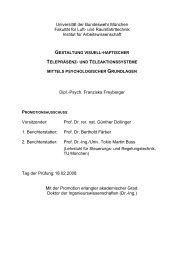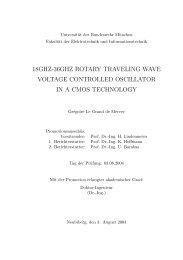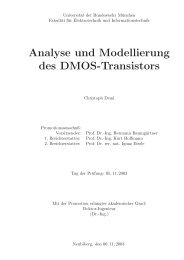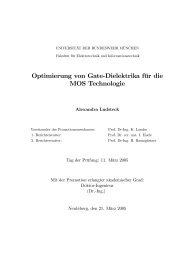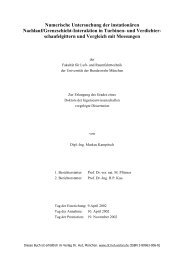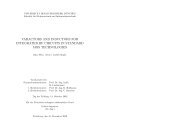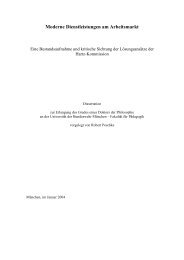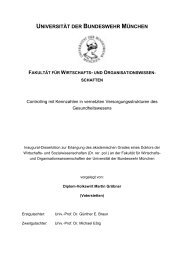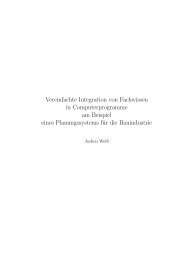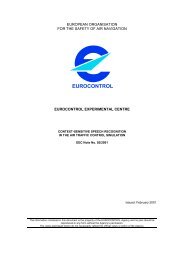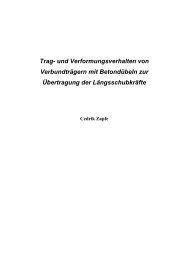Precise Orbit Determination of Global Navigation Satellite System of ...
Precise Orbit Determination of Global Navigation Satellite System of ...
Precise Orbit Determination of Global Navigation Satellite System of ...
Create successful ePaper yourself
Turn your PDF publications into a flip-book with our unique Google optimized e-Paper software.
Chapter 3 <strong>Orbit</strong> Tracking <strong>System</strong> and Their Error Budgets<br />
link ground station/ATS-6/GEOS-3. The specially processed range-rate measurements had a precision <strong>of</strong> about<br />
0.3 mm/s. Now ISL has been used for many scientific research projects, for examples, GRACE (Gravity<br />
Recovery and Climate Experiment) and CHAMP (Challenging Mini-<strong>Satellite</strong> Payload).<br />
The major observation <strong>of</strong> ISL is the one-way range, range rate and two-way range and range rate.<br />
3.2.3.2 Error Budget<br />
According to the discussions in the sections before, ISL error budget could be estimated as follows.<br />
Table 3-5 Error Budget for Possible ISL*<br />
Error Source Error<br />
Range (cm) Range Rate (mm/s)<br />
Ionosphere 0.0 0.0<br />
Troposphere 0.0 0.0<br />
Multipath 0.3 0.0<br />
<strong>Satellite</strong> Clock 9.5 >0.5<br />
*Assuming satellites orbiting in more than 1000 km altitude<br />
If ISL is used for GNSS-2 system, the advantage would be that atmospheric errors (ionosphere and troposphere)<br />
do not exist because IGSO, GEO and MEO satellites are far above the ionosphere and troposphere. The accuracy<br />
<strong>of</strong> the range rates (Doppler) will be very accurate and thus high accuracy <strong>of</strong> relative orbit determination can be<br />
achieved. Using ISL the onboard autonomous orbit determination is possible. The disadvantage is that frequency<br />
band <strong>of</strong> onboard receiver should be broader than that <strong>of</strong> the receiver on the ground, therefore the receiver errors<br />
are also significantly increased in ISL application. Another disadvantage is that the major satellite (orbiting<br />
platform) should be determined by the ground based tracking systems, therefore the absolute accuracy is still<br />
affected by atmosphere errors.<br />
3.2.3 <strong>Navigation</strong> <strong>System</strong> (GPS/GLONASS)<br />
GPS and GLONASS are satellite-based navigation systems that can be used in high precise positioning,<br />
navigation and time transfer applications. It can also be used for precise orbit determination <strong>of</strong> other earth orbit<br />
satellites, because on-board GPS/GLONASS receiver can track a number <strong>of</strong> GPS/GLONASS satellites.<br />
The GPS system consists <strong>of</strong> 28 satellite (March 2000) with 20200 km altitude above the earth’s surface and at<br />
least 4 satellites will be available anywhere on the earth, 24 hour a day. GPS satellite transmits signals at two<br />
frequencies L1=1575.42 MHz and L2=1227.6 MHz with C/A-code and P-code and navigation messages.<br />
GLONASS was developed by former Soviet Union and now consists <strong>of</strong> 22 satellites (March 2000). Its function<br />
is like GPS, which can also provide all-weather, continuous, real time and precise navigation capacity. The<br />
satellites transmit signals at two frequencies L1=1602 -1615 MHz and L2=1246 - 1256 MHz.<br />
The characteristics <strong>of</strong> two types <strong>of</strong> systems are listed in Table 3-6<br />
Table 3-6 Characteristics <strong>of</strong> GPS and GLONASS (Seeber 1993, Leick 1995, Teunissen et al, 1998)<br />
Feature GPS GLONASS<br />
<strong>Orbit</strong> height<br />
Period<br />
Frequencies<br />
<strong>Navigation</strong> Data<br />
Availability<br />
Coordinate system<br />
<strong>Satellite</strong> signal division<br />
Code type<br />
Accuracy<br />
20200 km<br />
12 h<br />
1575.42 MHz<br />
1227.60 MHz<br />
4D: x,y,z, t<br />
Velocity<br />
Continuous<br />
WGS 84<br />
Code division<br />
PRN sequence<br />
15 m (P-code without SA)<br />
28<br />
19100 km<br />
11 h 15 m<br />
1602-1615 MHz<br />
1246-1256 MHz<br />
4D: x,y,z, t<br />
Velocity<br />
Continuous<br />
PZ 90<br />
Frequency division<br />
Gold code<br />
10 m (P-code)



